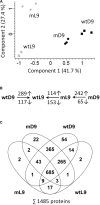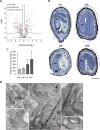The Role of Persulfide Metabolism During Arabidopsis Seed Development Under Light and Dark Conditions
- PMID: 30283487
- PMCID: PMC6156424
- DOI: 10.3389/fpls.2018.01381
The Role of Persulfide Metabolism During Arabidopsis Seed Development Under Light and Dark Conditions
Abstract
The sulfur dioxygenase ETHE1 oxidizes persulfides in the mitochondrial matrix and is involved in the degradation of L-cysteine and hydrogen sulfide. ETHE1 has an essential but as yet undefined function in early embryo development of Arabidopsis thaliana. In leaves, ETHE1 is strongly induced by extended darkness and participates in the use of amino acids as alternative respiratory substrates during carbohydrate starvation. Thus, we tested the effect of darkness on seed development in an ETHE1 deficient mutant in comparison to the wild type. Since ETHE1 knock-out is embryo lethal, the knock-down line ethe1-1 with about 1% residual sulfur dioxygenase activity was used for this study. We performed phenotypic analysis, metabolite profiling and comparative proteomics in order to investigate the general effect of extended darkness on seed metabolism and further define the specific function of the mitochondrial sulfur dioxygenase ETHE1 in seeds. Shading of the siliques had no morphological effect on embryogenesis in wild type plants. However, the developmental delay that was already visible in ethe1-1 seeds under control conditions was further enhanced in the darkness. Dark conditions strongly affected seed quality parameters of both wild type and mutant plants. The effect of ETHE1 knock-down on amino acid profiles was clearly different from that found in leaves indicating that in seeds persulfide oxidation interacts with alanine and glycine rather than branched-chain amino acid metabolism. Sulfur dioxygenase deficiency led to defects in endosperm development possibly due to alterations in the cellularization process. In addition, we provide evidence for a potential role of persulfide metabolism in abscisic acid (ABA) signal transduction in seeds. We conclude that the knock-down of ETHE1 causes metabolic re-arrangements in seeds that differ from those in leaves. Putative mechanisms that cause the aberrant endosperm and embryo development are discussed.
Keywords: amino acids; cellularization; cysteine degradation; embryogenesis; mitochondria; persulfide signaling.
Figures







Similar articles
-
The mitochondrial sulfur dioxygenase ETHYLMALONIC ENCEPHALOPATHY PROTEIN1 is required for amino acid catabolism during carbohydrate starvation and embryo development in Arabidopsis.Plant Physiol. 2014 May;165(1):92-104. doi: 10.1104/pp.114.239764. Epub 2014 Apr 1. Plant Physiol. 2014. PMID: 24692429 Free PMC article.
-
Arabidopsis ETHE1 encodes a sulfur dioxygenase that is essential for embryo and endosperm development.Plant Physiol. 2012 Sep;160(1):226-36. doi: 10.1104/pp.112.201855. Epub 2012 Jul 10. Plant Physiol. 2012. PMID: 22786886 Free PMC article.
-
Dealing with the sulfur part of cysteine: four enzymatic steps degrade l-cysteine to pyruvate and thiosulfate in Arabidopsis mitochondria.Physiol Plant. 2016 Jul;157(3):352-66. doi: 10.1111/ppl.12454. Epub 2016 Jun 3. Physiol Plant. 2016. PMID: 27105581
-
Protein polysulfidation-dependent persulfide dioxygenase activity of ethylmalonic encephalopathy protein 1.Biochem Biophys Res Commun. 2016 Nov 11;480(2):180-186. doi: 10.1016/j.bbrc.2016.10.022. Epub 2016 Oct 11. Biochem Biophys Res Commun. 2016. PMID: 27742479
-
The role of amino acid metabolism in signaling and metabolic adaptation to stress-induced energy deficiency in plants.J Exp Bot. 2021 Jun 22;72(13):4634-4645. doi: 10.1093/jxb/erab182. J Exp Bot. 2021. PMID: 33993299 Review.
Cited by
-
Identification of Low-Abundance Lipid Droplet Proteins in Seeds and Seedlings.Plant Physiol. 2020 Mar;182(3):1326-1345. doi: 10.1104/pp.19.01255. Epub 2019 Dec 11. Plant Physiol. 2020. PMID: 31826923 Free PMC article.
-
Bringing New Methods to the Seed Proteomics Platform: Challenges and Perspectives.Int J Mol Sci. 2020 Dec 1;21(23):9162. doi: 10.3390/ijms21239162. Int J Mol Sci. 2020. PMID: 33271881 Free PMC article. Review.
-
New role for thioredoxins in plants: Implication of TRXo1 in protein depersulfidation.Redox Biol. 2025 May;82:103627. doi: 10.1016/j.redox.2025.103627. Epub 2025 Apr 7. Redox Biol. 2025. PMID: 40220625 Free PMC article.
-
Genetic and Biochemical Investigation of Seed Fatty Acid Accumulation in Arabidopsis.Front Plant Sci. 2022 Jul 6;13:942054. doi: 10.3389/fpls.2022.942054. eCollection 2022. Front Plant Sci. 2022. PMID: 35909728 Free PMC article.
-
Temporal Control of Seed Development in Dicots: Molecular Bases, Ecological Impact and Possible Evolutionary Ramifications.Int J Mol Sci. 2021 Aug 26;22(17):9252. doi: 10.3390/ijms22179252. Int J Mol Sci. 2021. PMID: 34502157 Free PMC article. Review.
References
LinkOut - more resources
Full Text Sources
Molecular Biology Databases

